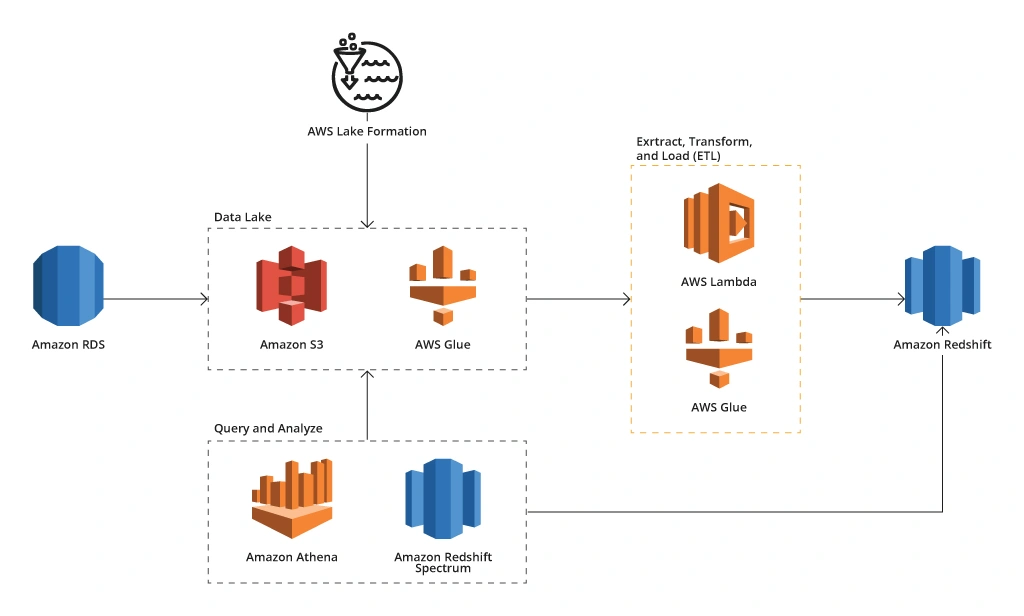Master AWS Glue: Automate ETL for Data Lakes Today
5 min read

Welcome to the exciting world of AWS Glue! If you've ever wondered how companies transform raw data into insightful reports at lightning speed, you're in the right place.
AWS Glue is a serverless data integration service.
It makes it simpler to discover, prepare, and combine data for analytics, machine learning, and app development.
Think of it as the secret sauce to streamlining data management, all without the hassle of managing infrastructure.
AWS Glue for Data Lake Transformation
Have you ever thought, “Do data lakes use ETL?” Absolutely, they do! Data lakes primarily use ELT (Extract, Load, and Transform) processes.
On the other hand, ETL (Extract, Transform, Load) happens in data warehouses.
AWS Glue shines in this aspect, automating the transformation process to ensure your data is ready for analytics.
This means you can move data effortlessly from a source system to your data lake. You can transform it along the way using AWS Glue's powerful tools.
By leveraging AWS Glue, businesses automate data lake operations.
This provides efficient data transformation and integration at scale. Its automation capabilities allow you to set up your data pipeline just once.
Then, you're good to go, saving both time and operational costs.

Mastering AWS Glue isn't merely about understanding its features. It's about leveraging them to create seamless data workflows.
These workflows power your organization's insights and innovation.
let’s talk about AWS Glue:
AWS Glue is renowned for its incredible high performance, allowing you to process massive volumes of data in real-time.
That's a game-changer, right? Plus, high availability is a given.
With automatic failover and disaster recovery features, downtime becomes a thing of the past. These aren't just tech terms; they're transformative advancements in data management!
AWS Glue vs. Other ETL Tools
AWS Glue is a powerhouse for big data solutions. It navigates through data lakes and warehouses as smoothly as a swan on a serene lake.
One major competitor is Azure Databricks, known for its high-performance data processing using Apache Spark.
However, Glue's automatic schema discovery and code generation make it a time-saver, cutting down on manual tasks.
I remember when I first tried different ETL tools.
The difference in ease of use and integration was glaring. AWS Glue integrates seamlessly with AWS services like S3, Redshift, and RDS. This smooth integration is priceless for anyone already in the AWS ecosystem.
And what about the cost? AWS Glue offers a pay-as-you-go pricing model.
That's fantastic for businesses of all sizes because you only pay for what you use. Say goodbye to budgeting for unused capacities!
Is Databricks Better Than AWS Glue?
That's a question that often pops up. Is Databricks better? Well, it all depends.
Azure Databricks excels in robust data analytics, powered by Apache Spark.
But whether you choose AWS Glue or Databricks depends on your specific needs, existing infrastructure, and budget.
Databricks might outperform AWS Glue in certain analytics-heavy scenarios, especially for advanced machine learning tasks.
Yet, AWS Glue shines with its seamless integration with AWS services. It’s a strong contender for many tasks.

So, if you're part of the AWS ecosystem, AWS Glue might just be the versatile workhorse your data tasks need.
Security and Management
Let's dive into the details of managing AWS Glue workflows. It's crucial to practice good security and management.
Streamlining your workflow is a game-changer, and AWS Glue is here to help. It's a solid solution for automating data processes.
Managing AWS Glue Workflows
Ever tried juggling multiple things at once? Creating AWS Glue workflows can be a bit like that at first. But once you know your way around, it's a breeze.
AWS Glue workflows let you connect different actions smoothly. This streamlines your whole ETL integration process.
It's not just about simplifying tasks—it's a strategic move. Imagine not having to start each job manually. Workflows automate this, ensuring everything runs seamlessly.
Creating a workflow in AWS Glue feels like aligning the stars. Start by setting up a series of jobs and crawlers.
You'll want to set triggers that get them started.
These can be based on time or events. With seamless ETL integration, you organize your data flow. Each task follows on logically from the last.
Why am I so excited about this? It makes complex data lakes simpler.
You create a system that works smoothly, with fewer errors. Ultimately, it saves you time. Consider it a well-tuned machine where every part knows its role and timing.
Efficient management and optimization of AWS Glue workflows can boost your data processing.
By using automated data pipelines, you are setting up a scalable plan. It's a future-ready solution that can grow with your business.

Conclusion
Reflecting on the myriad benefits of AWS Glue, it becomes evident how this powerful tool transforms ETL processes.
AWS Glue simplifies data management, making extract, transform, and load operations a breeze.
It integrates effortlessly with your existing cloud infrastructure.
Future of ETL Processes
There's a bright future for ETL processes, especially with innovations like AWS Glue leading the way.
Embracing cloud-based ETL ensures you always have the latest data transformation tools.
As more businesses choose AWS Glue for their ETL needs, performance and flexibility improve, while costs stay manageable.
I've been asked often: "Is AWS Lambda good for ETL?" Absolutely, AWS Lambda works wonders for ETL tasks. It's perfect if you're streamlining tasks.
You can use Lambda to run code, transforming data seamlessly from one place to another.
It's also a solid option for replacing traditional cron jobs. With schedule expressions, you can set regular intervals for running a Lambda function.
This method is much cheaper and more efficient than running cron on an EC2 instance. It makes data handling smarter and more efficient, without high costs.

